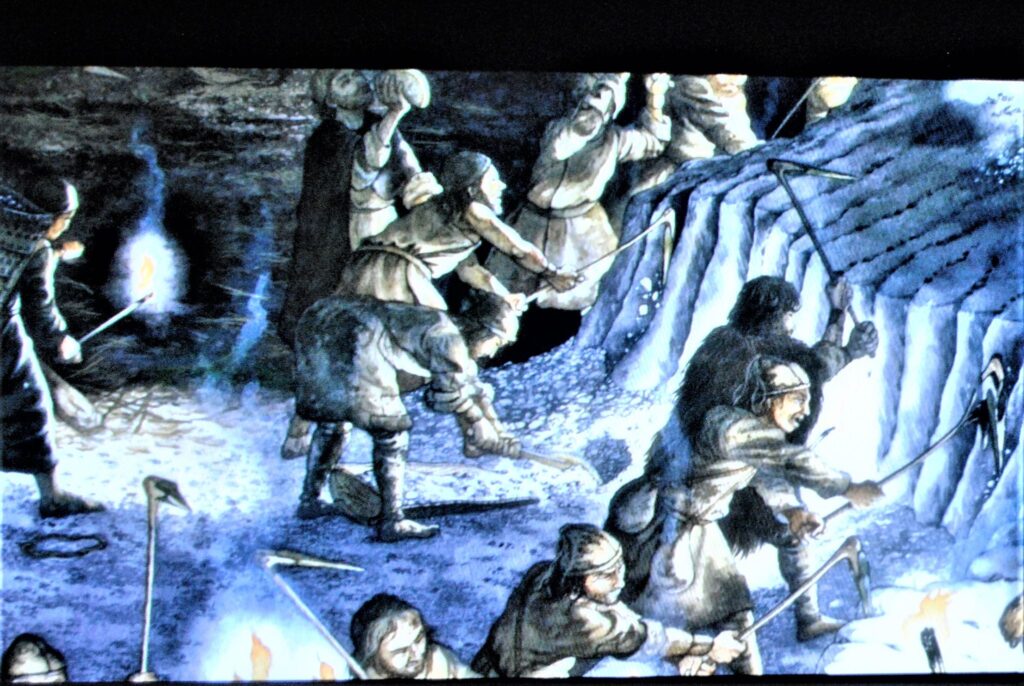 On my recent foray into the ancient Celts in Hallstatt and Hallein, Austria, I discovered why these areas were so prominent in history. White gold, or salt, was found in those mountains over 7,000 years ago. Neolithic man mined salt up through the Stone Age using picks made of antlers. This mining process became easier as man began using tools made of bronze. But this is a softer metal, and it wasn’t until the Iron Age that the tools enabled increased production.
On my recent foray into the ancient Celts in Hallstatt and Hallein, Austria, I discovered why these areas were so prominent in history. White gold, or salt, was found in those mountains over 7,000 years ago. Neolithic man mined salt up through the Stone Age using picks made of antlers. This mining process became easier as man began using tools made of bronze. But this is a softer metal, and it wasn’t until the Iron Age that the tools enabled increased production.
People were able to preserve food on a much larger scale. Trade with distant lands allowed for other goods not locally available such as silver, amber, silk, and wine. It also allowed for the exchange of ideas and cultures. Additionally, border stations popped up to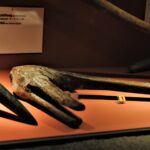 collect customs duties, increasing the wealth in those areas. Salt is still mined in the High Valley above Hallstatt today. It comes as no surprise that this area thrived and grew wealthy. In 1311 when documentation on mining began, it was evident that these miners were not the first to dig deeply into the earth’s surface. In the 19th century, the largest prehistoric cemetery in Europe was discovered adjacent to the mines. The salt in the soil preserved many items not generally found, such as fabric, wood, leather, food, and other goods. Typically only metal, ceramics, and bones remain.
collect customs duties, increasing the wealth in those areas. Salt is still mined in the High Valley above Hallstatt today. It comes as no surprise that this area thrived and grew wealthy. In 1311 when documentation on mining began, it was evident that these miners were not the first to dig deeply into the earth’s surface. In the 19th century, the largest prehistoric cemetery in Europe was discovered adjacent to the mines. The salt in the soil preserved many items not generally found, such as fabric, wood, leather, food, and other goods. Typically only metal, ceramics, and bones remain.
According to the Roman statesman Cassiodorus, “Mankind can do without gold, but not without salt.” Pliny, the Elder, claims, “Heaven knows a civilized life is impossible without salt.” No wonder the ancient Celts did so well trading this valuable commodity. After all, it enabled people to settle in one location and become more self-sufficient on a broader scale. They no longer had to harvest or kill and eat the food immediately. With the new iron farming tools and salt readily available, people formed larger settlements than ever before, and populations thrived.
My daughter and her family have established a small homestead and are experimenting with older preservation methods. So, after my Austrian visit, I googled 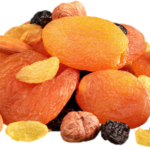 the history of food preservation. Today we don’t think much about it. We buy items at the market and throw them in the refrigerator or freezer. Today we can purchase processed foods with a long shelf-life. But these are modern inventions. I decided to travel back in time, exploring the old ways of storing food.
the history of food preservation. Today we don’t think much about it. We buy items at the market and throw them in the refrigerator or freezer. Today we can purchase processed foods with a long shelf-life. But these are modern inventions. I decided to travel back in time, exploring the old ways of storing food.
From the earliest times, man dried items using the sun or the wind depending on the local climate. Middle Eastern cultures actively dried food items as early as 12,000 BC. This technique was probably not very efficient as weather can be fickle. Evidence shows that the Romans were particularly fond of dried fruits. Drying food continued and is still used today, though the process has changed, no longer reliant on the sun and the wind.
Another process, more likely stumbled upon than invented, is fermentation. Many historians believe beer was discovered when grains of barley were left in the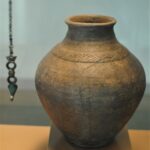 rain and microorganisms turned the starch into alcohol. Around 10,000 BC, man began to settle down and grow barley. It was a gift from the gods. Turning cabbage into sauerkraut is a similar practice, and man began to study and encourage this process—staples such as Kim Chi were born.
rain and microorganisms turned the starch into alcohol. Around 10,000 BC, man began to settle down and grow barley. It was a gift from the gods. Turning cabbage into sauerkraut is a similar practice, and man began to study and encourage this process—staples such as Kim Chi were born.
Pickling is similar to fermentation but uses vinegar, a fermented starch or sugar, that has been exposed to a specific bacteria and turned into acetic acid. It is thought that pickling originated by storing food in beer or wine. Possibly the beer went sour, but the food tasted better. No one knows exactly how it came about, but it became a popular method. The Romans loved the pickled fish sauce, known as garum. In the Oppidum of Manching, an ancient Celtic site about an hour from my home, amphorae were found with traces  of garum in the bottom. I wonder what they traded to Rome for that?
of garum in the bottom. I wonder what they traded to Rome for that?
Curing meat was initially done by dehydration using salt. It allowed people to kill some of the herd before winter and use the salt-preserved meat to survive the cold season. They also did not have to feed as many animals during this time.
Most of us are familiar with canning, where food is placed in jars or cans and heated to destroy the microorganisms, thus preserving the food. Heating and cooling also form a vacuum seal protecting the food inside.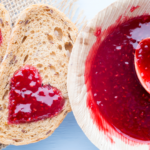
And who doesn’t love jams and jellies? I sure do. Using sugar or honey for preserving food has been found in the earliest cultures. The Greeks, especially, were fond of using honey. Anyone who has visited a Cretan family will be familiar with spoon sweets. These are a preserved, sweet treat served on a spoon as a gesture of hospitality. Bitter or sour fruits preserved in honey are particularly favored.
And finally, there is cooling and freezing. As I mentioned, we use refrigerators and freezers today. Still, any area with cold weather  knows the benefits of taking advantage of placing food in cold running streams. Cellars and caves with cooler temperatures were commonly used for food storage.
knows the benefits of taking advantage of placing food in cold running streams. Cellars and caves with cooler temperatures were commonly used for food storage.
This is by no means a complete list of methods, nor does it detail each process, but I hope you’ve enjoyed learning about the various options used over time. I knew the name Hallstatt had been attached to the earliest Celts in Europe, and after visiting, I understand why. They turned a product into a global trading business, a mine of white gold.
